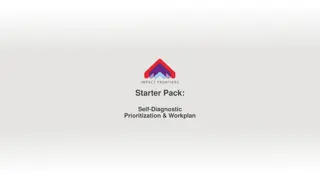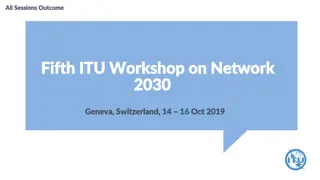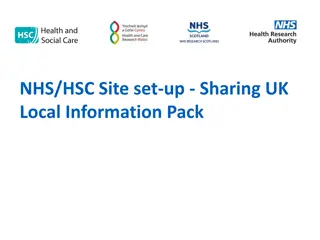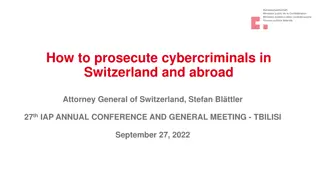LIBOR Transition in Switzerland: Starter Pack Overview
This starter pack by the National Working Group on Swiss Franc Reference Rates provides essential information on transitioning from CHF LIBOR to SARON. It covers the importance of LIBOR, details about SARON, challenges, and the role of the NWG in reform initiatives. The pack aims to facilitate discussions with stakeholders and enhance understanding of the transition process. For additional details, visit the provided links and contact the NWG for questions and suggestions.
Download Presentation

Please find below an Image/Link to download the presentation.
The content on the website is provided AS IS for your information and personal use only. It may not be sold, licensed, or shared on other websites without obtaining consent from the author.If you encounter any issues during the download, it is possible that the publisher has removed the file from their server.
You are allowed to download the files provided on this website for personal or commercial use, subject to the condition that they are used lawfully. All files are the property of their respective owners.
The content on the website is provided AS IS for your information and personal use only. It may not be sold, licensed, or shared on other websites without obtaining consent from the author.
E N D
Presentation Transcript
LIBOR transition in Switzerland: Starter pack National Working Group on Swiss Franc Reference Rates Version: February 2019
About this pack This pack is designed to inform readers about the transition from CHF LIBOR to SARON. For instance, it may be used when engaging with internal and external stakeholders on the topic. It was developed by the National Working Group on Swiss Franc Reference Rates (NWG), which is the key forum for considering proposals to reform reference interest rates in Switzerland. Further details about the NWG can be found on Slide 12. Questions and suggestions will be gratefully received and may be sent to nwg@snb.ch. 2
Agenda 1. Importance of and issues with LIBOR 2. What is SARON? 3. SARON as alternative to CHF LIBOR 4. Compounded SARON as term rate alternative to LIBOR 5. Current challenges 5.1. Options for using a compounded SARON 5.2. Enhancing contractual robustness 5.3. Promoting operational readiness 5.4. Development of a SARON ecosystem 6. NWG on Swiss Franc Reference Rates 7. NWG milestones 8. International overview of reform initiatives 9. Additional information and links 3
1. Importance of and issues with LIBOR What is LIBOR and why is it important? Figure 1: basis for pricing of loans in CHF (SNB Bank Lending Survey, 2018) The London Interbank Offered Rate (LIBOR) is a measure of the average rate at which banks are willing to borrow wholesale unsecured funds. It is administered by the ICE Benchmark Administration and is calculated as a trimmed mean of submissions from selected panel banks. It is published in five currencies (USD, GBP, EUR, CHF, JPY) and a range of tenors (ON/SN, 1W, 1M, 2M, 3M, 6M, 12M). LIBOR is the most widely used interest rate benchmark and serves as a price reference for a broad range of financial instruments, such as loans, bonds, and derivatives (Figure 1). The volume of outstanding financial contracts that reference LIBOR is estimated at approx. USD 300 tn globally with approx. USD 6.5 tn in CHF LIBOR (FSB, 2014). What is the problem with LIBOR? Figure 2: proportion of panel bank submissions used to calculate LIBOR that are transaction-based, transaction-derived or based on expert judgement (ICE, 2018) The underlying market of CHF LIBOR is no longer liquid. Activity has shifted from the unsecured to the secured money market since the global financial crisis. As a consequence, the calculation of CHF LIBOR is almost entirely based on expert judgement instead of actual transactions (Figure 2). Panel banks are uncomfortable about providing submissions based on expert judgement. The Financial Conduct Authority (FCA), the regulatory authority supervising LIBOR s administrator, has announced that it will neither persuade nor compel banks to participate in LIBOR panels after the end of 2021. LIBOR s existence beyond 2021 is thus highly uncertain and a transition to alternative reference rates is inevitable. 4
2. What is SARON? The Swiss Average Rate Overnight (SARON) reflects the conditions for overnight transactions in the secured CHF money market. SARON is administered by SIX Swiss Exchange (SIX). SARON is calculated immediately after the market has closed (6 p.m.) with further fixings during the day at 12 noon and 4 p.m. SARON has clear governance structures in place and complies with international benchmark standards. At the beginning of 2017, SIX founded the SRR Index Commission, which periodically reviews all aspects of SARON. SARON is calculated as a volume-weighted average of transactions and binding quotes in the order book of SIX s electronic trading platform. A filter is used in order to exclude outliers. The methodology, which was developed in coordination with the SNB, is transparent and publicly available. Slide 6 summarises the key characteristics that make SARON a robust and representative CHF benchmark and underpin the NWG s decision to recommend SARON as the alternative to CHF LIBOR. The overnight segment of the CHF repo market is the most liquid segment of the CHF money market. Figure 3 shows the development of the calculation basis (rate volume) for SARON since 1999. Figure 3: SARON rate volume (SIX, 2018) 5
3. SARON as alternative to CHF LIBOR Secured overnight money market conditions are reflected at all times. Based on actual transactions and binding quotes submitted by a set of more than 160 active market participants in the regulated Swiss repo market. Represents by far the most liquid segment of the CHF money market. Representative Methodologyistransparent and publicly available. Counterparty default risk is minimized in the repo market and outliers are excluded. Therefore, SARON is resilient in times of market stress. Robust Established in 2009 and calculated back to 2000, with daily fixings. Administered by SIX, which operates infrastructure for the Swiss financial centre. Complies with international benchmark standards. Methodology developed in conjunction with SNB;regularly reviewed by an index commission. Administered in Switzerland 6
4. Compounded SARON as term rate alternative to CHF LIBOR Difference between contracts linked to 3M LIBOR and compounded SARON NWG recommends using compounded SARON as term rate When using a term reference rate such as 3M LIBOR as a benchmark in a financial contract, interest payments are already known at the beginning of the interest period (Figure 4, left-hand side). This type of forward-looking term rate reflects the expected level of interest for the next three months and is equivalent to a sequence of expected overnight rates. In order to facilitate the transition away from LIBOR, the NWG has assessed the feasibility of a forward-looking term rate based on SARON derivatives, such as SARON swaps and futures. The NWG believes a robust fixing of a forward- looking term rate based on SARON-derivatives is unlikely to be feasible. It thus recommends using a compounded SARON wherever possible. When using compounded SARON as a benchmark in a financial contract, interest payments are the result of daily compounded interest rates (Figure 4, right-hand side). This type of compounded term rate reflects the realised level of interest for the past three months and is equivalent to a sequence of realised overnight rates. Whether interest payments are known at the beginning of the interest period depends on how a compounded SARON is applied. It is possible to implement a compounded SARON where interest payments are known at the beginning of the period (compounded SARON in advance). Compounding is preferred to a simple average, as compounding is the standard convention on the swap market. Compounded SARON follows 3M LIBOR closely and tends to be relatively predictable (Figure 5). Compared to 3M LIBOR, compounded SARON is less volatile. Additionally, as SARON does not entail a credit spread premium, the rate tends to be lower and more stable in times of market turbulence. Figure 5: development of 3M CHF LIBOR, SARON, 3M SARON compounded over time (Bloomberg, SNB, 2018) Figure 4: comparison of a contract referencing 3M LIBOR vs. compounded SARON 7
Current challenges 5.1 Options for using a compounded SARON Different forms of cash flow uncertainty require different solutions NWG sets out options for market participants consideration After recommending the use of a compounded SARON as a term alternative to CHF LIBOR, the NWG published specific options on how a compounded SARON could be used as a benchmark in financial contracts, such as loans, mortgages, and capital market instruments. Underlying these options is the question of how best to mitigate uncertainty about future cash flows a factor that is inherent in a compounded approach. The NWG has proposed several options for using a compounded SARON (Figure 6). First, options for compounded SARON in arrears, of the kind already used in the derivatives market; here, the next interest payment is known a couple of days before the payment is due. Second, options for compounded SARON in advance; here, the next payment is already known at the beginning of a given interest period. Broadly, uncertainty regarding future interest payments falls into three categories and the preferred solution will depend on the type of certainty a market participant requires when it comes to interest payments. The NWG recommends market participants consider and asses these options. Additionally, it recommends that each financial institution defines an action plan with respect to its product strategy. 1. If a market participant has a fundamental aversion to variable future interest payments (i.e. payments that are ex-ante unknown), buying a fixed-rate product is the best option. With a fixed-rate product, cash flows for all periods are known from inception and no benchmark is required (cash flow certainty over lifetime of product). Figure 6: overview of options for using compounded SARON (NWG, 2019) 2. If a floating-rate product is preferred but the next cash flow instalment must be known at the beginning of each interest rate period (as is the case with LIBOR-linked contracts), an in-advance option is suitable (cash flow certainty for a single period). 3. If a floating-rate product is preferred and an interest rate payment known close to the end of a period can be tolerated (e.g. from a cash management perspective), an in-arrears option is suitable. 8
Current challenges 5.2. Enhancing contractual robustness Fallback provisions as safety net for contracts maturing beyond 2021 Efforts to enhance fallback provisions for derivatives and loans Fallback provisions support contract continuity and enable the conversion of contracts if LIBOR ceases to exist. Existing financial contracts often do not contain fallback provisions. The adoption of appropriate fallbacks will help to reduce the risk of market participants finding themselves in disagreement or dispute on rights and obligations attached to LIBOR-referencing contracts. For derivatives, the International Swaps and Derivatives Association (ISDA) is working on an amendment to the 2006 ISDA Definitions that will include fallbacks to LIBOR and a protocol to include the amended definitions in existing transactions (Figure 7, top). During summer 2018, ISDA conducted a public consultation in which it assessed how to construct fallback rates from alternative risk-free rates (RFR). In December 2018, ISDA published the results of the consultation indicating that the development of the fallbacks will be based on a compounded setting in arrears for the RFR, with a historical mean/median approach being applied for the spread adjustment. However, fallback provisions are not designed as the primary transition mechanism. They serve as a safety net in the event that LIBOR ceases to exist and they should not be relied upon. The smoothest and best way to transition is to reduce exposure to CHF LIBOR before 2021 and conclude new business using SARON. Loan contracts are less standardized than derivatives and they typically fall under local law. Each institution must therefore implement appropriate fallback mechanisms for new contracts, as well as amendments to existing LIBOR- referencing contracts, individually. A proposal for a draft fallback template has been developed for new retail loan contracts (Figure 7, bottom). Figure 7: overview of workstreams on enhancing contractual robustness for derivatives and loans 9
Current challenges 5.3. Promoting operational readiness Becoming operationally ready requires a high level of coordination within an institution Project management Ensure senior management awareness and set up internal LIBOR transition project LIBOR is embedded in firms operating models. Transitioning to alternative rates will affect how contracts are written and priced, risks managed and IT systems operated. Legacy contracts referencing LIBOR Quantify exposure to LIBOR across products Assess contractual terms regarding fallback to RFRs Define transition strategy in order to avoid contract frustration Amending the operating models will require time and substantial resources. It is therefore important for affected institutions to initiate a concrete action plan detailing how they intend to address the challenges presented by the transition. New contracts referencing LIBOR Determine adequate fallback provisions Implement fallback provisions for existing products and conclude contracts with updated fallback language Products and contracts The NWG has developed a checklist to help LIBOR users improve operational readiness ahead of the transition to alternative RFRs. New contracts referencing alternative RFRs Develop new products referencing alternative RFRs FINMA guidance on transition away from LIBOR FINMA has published guidance (Aufsichtsmitteilung) on the risks involved in transitioning away from LIBOR and has recommended that supervised entities address these challenges in good time. Furthermore, FINMA will be discussing with supervised institutions how to ensure the adequacy of any measures the latter may have taken to monitor, identify and limit transition risks. Communication and training Ensure internal flow of information to all stakeholders Reach out to counterparties regarding changes to existing contracts Assess impact on accounting (particularly hedge accounting), as well as valuation and cash flow projections Assess the impact on taxes Accounting and treasury Assess impacted IT systems Ensure IT systems can handle new products Engage with software providers and data providers Operational requirements 10
Current challenges 5.4. Development of a SARON ecosystem In order to facilitate the transition from LIBOR to SARON, it is important to develop a liquid ecosystem of products linked to SARON, such as futures, swaps, loans, floating-rate notes, etc. Use of LIBOR in financial products A range of financial products, such as derivative contracts or floating-rate mortgages, are directly linked to LIBOR. Equally, LIBOR is used to price and value a large number of contracts (e.g. bonds). This is done using the curve generated by LIBOR-linked derivatives such as swaps and futures (Figure 8). This is particularly pronounced in Switzerland, where the LIBOR-based swap curve plays a very important role, as liquidity in the government bond market is relatively low. SARON-based derivatives products The SARON swap market was established in 2017 as a replacement for the TOIS fixing. While the volume of outstanding contracts increased significantly during 2018, it remains significantly below the volume of LIBOR-linked interest rate swaps. In June 2018, the NWG published a term sheet for SARON futures. Since October 2018, SARON futures have been trading on Eurex. Figure 8: LIBOR serves as a pricing reference for various financial markets SARON-based cash products To date, there has been no market for cash products based on SARON. Establishing (compounded) SARON as a RFR for cash products would likely increase liquidity in the SARON-based derivatives market as such a development would stimulate demand for hedging. The NWG is working on identifying various options for using a compounded SARON in cash products such as loans, mortgages, and capital market instruments (see Slide 8). The NWG has assessed the use of SARON for floating-rate notes (FRN) and sees no impediments to issuing SARON FRNs. 11
6. NWG on Swiss Franc Reference Rates The NWG is the key forum to foster the transition to SARON and to discuss the latest international developments. The NWG is co-chaired by a representative of the private sector and a representative of the Swiss National Bank (SNB). The SNB acts as a moderator and runs the technical secretariat. The NWG will cease to exist once the transition to SARON is materially completed. The NWG includes all relevant stakeholders affected by the LIBOR transition. It currently comprises representatives of banks, insurance companies, corporates, financial market infrastructure providers, international institutions, public institutions, and stakeholder associations. The NWG maintains a regular dialogue with other working groups in order to coordinate and exchange information on international reform efforts. The NWG was initially established in 2013 to reform the TOIS fixing. Since the successful replacement of the TOIS fixing with SARON, the NWG has been concentrating on the transition from CHF LIBOR to SARON. Two sub-working groups are focusing on the transition away from LIBOR in loan and deposit markets (ToR Sub-NWG L&D) and in derivatives and capital markets (ToR Sub- NWG D&C) respectively (Figure 9). For cross-currency swaps, the NWG engages in the international sub-working group convened by the Alternative Reference Rates Committee. Figure 9: organizational structure of the NWG 12
7. NWG milestones NWG recommends market participants to consider and assess options for using a compounded SARON. Each financial institution is advised to define an action plan with respect to its product strategy. February 2019 NWG recommends using compounded SARON wherever possible as a term rate alternative. NWG considers it unlikely that a robust term rate based on SARON derivatives will be feasible. NWG releases checklist to help market participants become operationally ready for LIBOR transition and discusses proposal for fallback template for retail loans. SARON futures start trading on Eurex in October 2018. October 2018 NWG releases recommended specifications for SARON futures (term sheet). June 2018 TOIS fixing is discontinued. December 2017 NWG recommends SARON as alternative to CHF LIBOR and establishes two sub-working groups to focus on a possible transition away from LIBOR in loan and deposit markets (ToR Sub-NWG L&D) as well as in derivatives and capital markets (ToR Sub-NWG D&C). Clearing of SARON swaps commences on LCH and Eurex. October 2017 Administrator of TOIS fixing, ACI Suisse, announces discontinuation of TOIS fixing effective December 2017 November 2016 NWG decides to focus reform efforts on SARON as alternative to TOIS fixing. Between 2013 and 2016, multiple reform efforts with respect to TOIS fixing are undertaken (summary). However, it becomes apparent that these efforts will not be sufficient to ensure a viable reference rate in long run. January 2016 NWG is established to reform TOIS fixing. June 2013 13
8. International overview of reform initiatives Working Group on Sterling Risk-Free Reference Rates Cross-Industry Committee on Japanese Yen Interest Rate Benchmarks Alternative Reference Rates Committee Working Group on Euro Risk-Free Rates National Working Group on CHF Reference Rates Working group SOFR (Secured Overnight Financing Rate) SONIA (Sterling Overnight Interbank Average Rate) ESTER (Euro-Short Term Rate) SARON (Swiss Average Rate Overnight) TONA (Tokyo Overnight Average Rate) Alternative reference rate Unsecured overnight funds Unsecured overnight funds Unsecured overnight funds Underlying market Secured overnight funds Secured overnight funds Published since 3 April 2018 Reformed since 23 April 2018 Expected for Q4 2019 Published since 2009 Published since 1992 Publication date Federal Reserve Bank of New York Bank of England European Central Bank SIX Swiss Exchange Bank of Japan Administrator Sources: NY Fed, BoE, ECB, SNB, BoJ Development of derivatives-based term rate as soon as practicable and only if robust in order to facilitate transition in certain cash markets Public consultation on methodology for a forward-looking term rate as a fallback for EURIBOR-linked contracts; recommendation expected Derivatives-based term fixing not feasible; recommendation to use compounded SARON wherever possible Development of forward- looking term rate not before end-2021 Development of term structure To be discussed 14
9. Additional information and links International working groups Switzerland: National Working Group on CHF Reference Rates USA: Alternative Reference Rates Committee UK: Working Group on Sterling Risk-Free Reference Rates Euro area: Working Group on Euro Risk-Free Rates Japan: Cross-Industry Committee on Japanese Yen Interest Rate Benchmarks National initiatives FINMA guidance LIBOR: risks of potential replacement Illustrative publication of SARON compounded rates by SIX Proposal for draft fallback template for new retail loans International initiatives Financial Stability Board s Official Sector Steering Group FSB Progress Report 2018 Andrew Bailey (CEO of the Financial Conduct Authority) held two important speeches in July 2017 and July 2018 ISDA work stream on derivatives fallbacks for IBOR benchmark rates 15
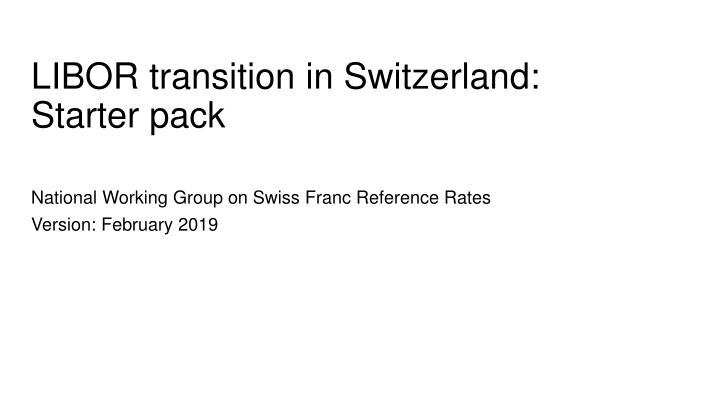


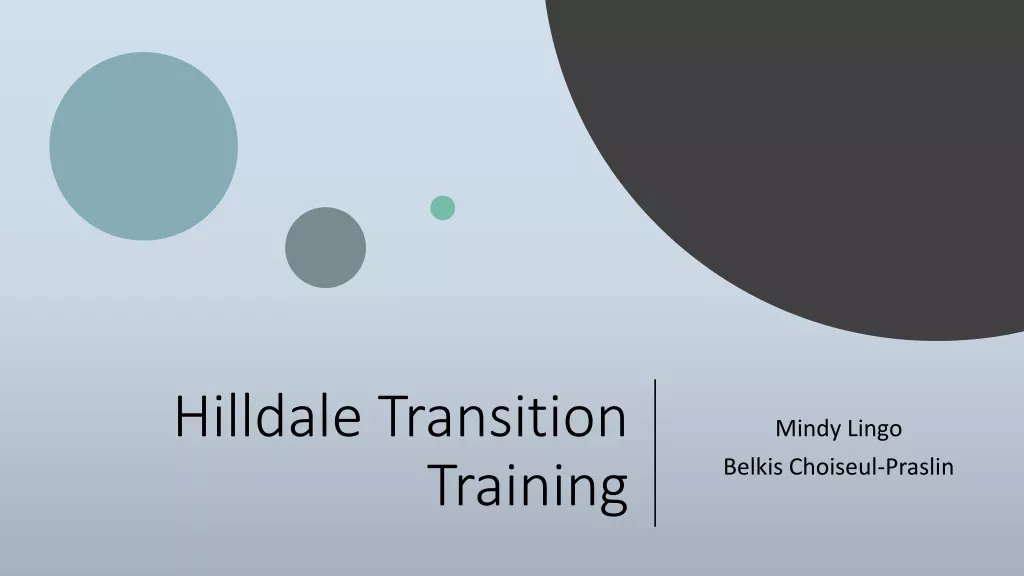
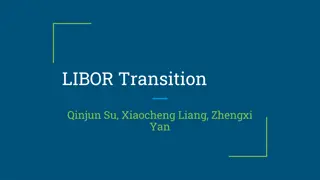



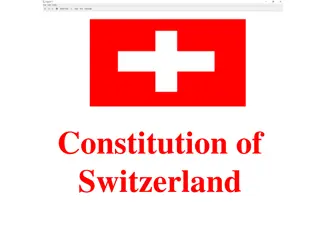

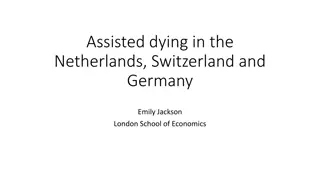



![USA Swimming and [Insert LSC Here] Starter Clinic Overview](/thumb/162824/usa-swimming-and-insert-lsc-here-starter-clinic-overview.jpg)
